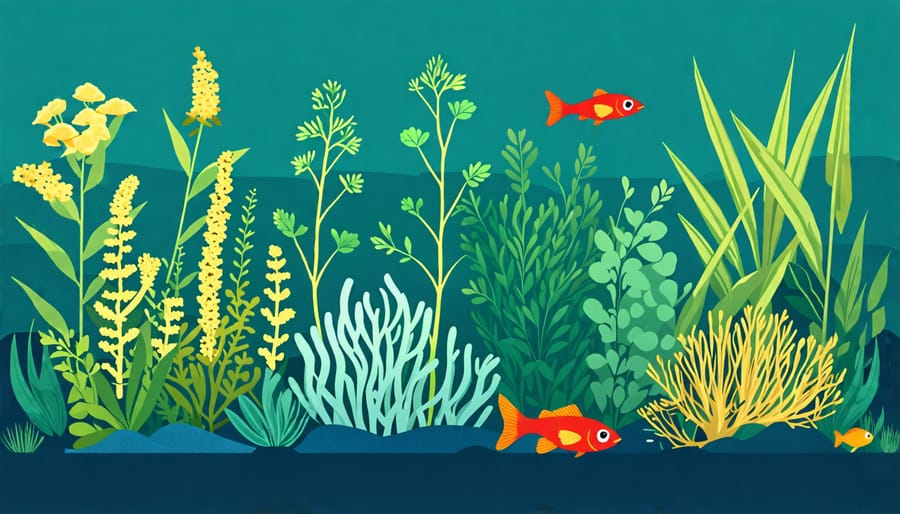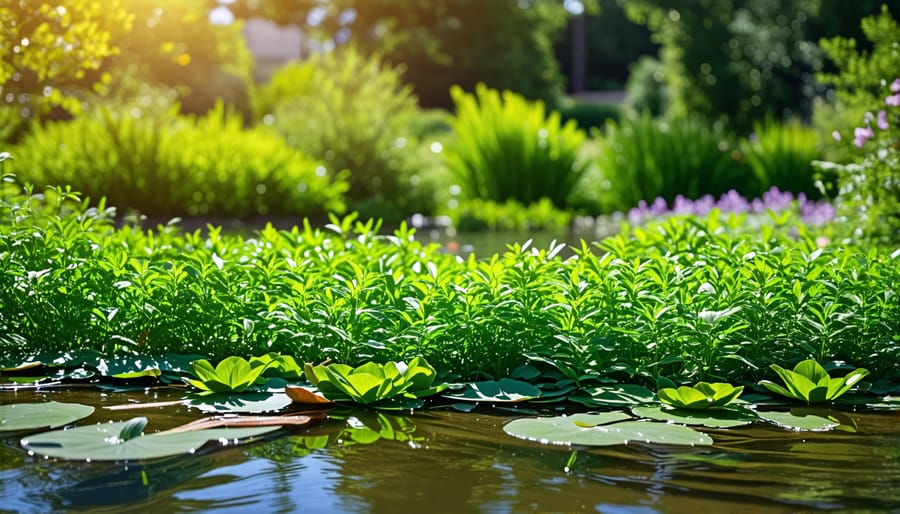
Is Your Pond at Risk? The Battle Against Invasive Pond Plants
Remove invasive pond plants by identifying them early; look for species like Eurasian watermilfoil and water hyacinth, which spread aggressively. Gradually clean them out using a rake or aquatic weed cutter, ensuring roots are removed to prevent regrowth. Introduce native pond plants that balance the ecosystem, such as pickerelweed or duckweed, which compete with invasives for resources. Regularly monitor and maintain your pond, checking for any signs of new invasions, and adjust water levels or nutrient inputs to discourage invasive growth.
Understanding Invasive Pond Plants
Characteristics of Invasive Species
Invasive pond plants are intriguing yet troublesome for water gardeners and pond enthusiasts. These plants have unique characteristics that allow them to thrive aggressively and outcompete native species. Firstly, many invasive species grow rapidly. They have a high reproduction rate, quickly covering large areas of your pond and outshading slower-growing native plants. These invaders often utilize strategies like prolific seed production or vegetative propagation, spreading swiftly without needing to rely on pollinators or specific environmental conditions.
Additionally, invasive pond plants are highly adaptable. They flourish in various conditions and resist common diseases and pests, challenging the delicate balance of your pond’s ecosystem. Their resilience can lead to monocultures, where a single species dominates, reducing biodiversity and altering habitats vital for local wildlife. For those looking to maintain a healthy water garden, it’s crucial to identify and manage these species. You might find useful tips in our wildlife pond guide, where we cover creating balanced habitats. These steps not only enhance your pond’s aesthetics but also protect its natural beauty and health for long-term enjoyment.
Common Invasive Pond Plants
When it comes to invasive pond plants, a few notorious culprits can quickly take over your serene water garden. Water hyacinth is one of the most commonly known invaders. These floating plants have beautiful, lavender-blue flowers, but they multiply at an alarming rate, often forming dense mats that block sunlight and deplete oxygen levels, wreaking havoc on your aquatic ecosystem.
Eurasian watermilfoil is another invasive species to keep an eye on. With its feathery leaves and reddish stems, it may look attractive, but its rapid growth can outcompete native plants and create tangled masses, making it difficult for fish and other creatures to navigate.
Curly-leaf pondweed, with its distinctive wavy-edged leaves, can also be problematic. It tends to sprout early in the season, getting a head start and overshadowing native plants, which can lead to a decline in biodiversity.
As a pond owner, it’s essential to regularly check for these plants and take proactive measures to manage them, ensuring your pond remains a beautiful and balanced habitat.

Impact of Invasive Plants on Pond Ecosystems
Effects on Fish and Aquatic Life
Invasive pond plants can significantly disrupt the delicate balance of your water garden, affecting both fish and other aquatic life. These unwelcome guests may sound like just another gardening hurdle, but their impact is far from minor. Imagine trying to maintain a thriving plant and fish ecosystem while these newcomers are busy altering oxygen levels in the water. As these invasive plants grow excessively, they might outcompete native species for sunlight and nutrients, leading to lower oxygen production. This can create stress for your fish, who rely on well-oxygenated water to breathe and thrive.
Moreover, invasive plants are notorious for changing habitat structures. They can form dense mats on the water’s surface or below, hindering aquatic life from moving freely. These mats may block light, vital for photosynthesis for native underwater plants, causing a domino effect on the aquatic ecosystem. Without intervention, fisheries could suffer from reduced biodiversity as native species decline, leaving your serene pond far less diverse. Understanding these impacts helps pond enthusiasts better manage and prevent these invasive intruders, ensuring a healthier, more balanced aquatic environment.

Consequences for Native Pond Vegetation
Invasive pond plants might look pretty, but they can cause quite a stir in your water garden! These uninvited guests often grow rapidly, overshadowing and even taking over the existing native pond vegetation. Picture this: your cherished lilies and native reeds struggling to breathe under a thick blanket of foreign greenery. This isn’t just an aesthetic problem; it’s an ecological one too. Native plants play a crucial role in maintaining the pond’s natural balance, providing food and habitat for local wildlife. When invasive species move in, they can upset this delicate harmony. Your pond’s ecosystem might suffer as native species are pushed out, leading to reduced biodiversity.
A pond bustling with diverse plants is usually healthier and more resistant to pests and diseases. Unfortunately, when invasive plants dominate, it’s like having a one-sided conversation at a party—there’s not much room for diversity! This can lead to a less robust ecosystem that’s prone to problems. But don’t worry, you can help your pond bounce back! Being proactive in identifying and managing these invasive intruders ensures your pond remains a thriving, balanced ecosystem full of life and beauty. Remember, each native plant you save contributes to a vibrant and healthy pond environment!
Prevention and Control Strategies
Prevention Tactics for Pond Owners
Keeping your pond free from invasive plants requires a few proactive steps, perfectly suited for both seasoned enthusiasts and those just starting their water gardening journey. First, always start with certified, healthy plants from reputable suppliers. This reduces the risk of unintentionally introducing unwanted species. Before adding any new plants, rinse and inspect them thoroughly for hidden hitchhikers. Debris such as soil or roots can harbor invasive species that quickly disrupt your pond’s ecosystem.
Next, consider creating a quarantine area for new plants. Set aside a separate container filled with water where you can observe them for a couple of weeks. This strategy helps you catch and address any invasive tendencies before they spread.
Another key tactic is regular maintenance. Dedicate some time each month to trimming and removing excess growth. This not only keeps your pond looking its best but also prevents any potentially invasive plants from gaining a foothold. Don’t forget to dispose of plant waste carefully, as improperly discarded vegetation can find its way to local waterways.
Lastly, sharing your love for pond plants can be rewarding but risky. If exchanging plants with friends or neighbors, make sure you’re only sharing non-invasive species. By following these simple steps, you can enjoy the beauty of your pond without the worry of invasive plants taking over.

Effective Management Techniques
Managing invasive pond plants can transform your water garden into a thriving, balanced ecosystem. Let’s explore some effective techniques to keep these unwanted visitors at bay. Physical removal is often the first line of defense. Outfitted with basic tools like rakes and nets, you can manually pull or cut the invasive plants. While this method requires some elbow grease, it’s rewarding to see the immediate improvement in your pond’s appearance.
For a bit more finesse, biological control offers a natural, eco-friendly approach. This involves introducing certain species of fish or aquatic insects that naturally feed on the invasive plants, helping to restore the ecological balance without the need for chemicals. Always research to ensure your chosen biological control won’t become invasive itself.
Finally, consider using herbicides as a targeted approach. These chemical solutions can effectively reduce the population of invasive species when applied correctly. Remember to choose herbicides specifically designed for aquatic environments to avoid harming beneficial plant life and wildlife.
A combination of these methods, along with regular maintenance tips, can effectively combat invasive plants. Whether it’s rolling up your sleeves for some manual labor or opting for natural or chemical solutions, managing your pond can be an engaging and satisfying journey.
Conclusion
Ensuring your pond remains a thriving and beautiful ecosystem requires dedicated care and responsibility. In this article, we’ve explored the crucial aspects of managing invasive plants and maintaining a harmonious water garden. By embracing regular maintenance and early intervention, you can prevent the spread of unwanted plant species and protect the natural balance of your pond. Remember, each step you take towards responsible pond management not only enhances the aesthetic appeal of your outdoor space but also supports the ecological health of your surroundings. Whether you’re just starting out or are a seasoned enthusiast, every effort counts. So, take the knowledge you’ve gained here to heart and begin implementing effective strategies today. Your pond will thank you, providing years of tranquility and beauty. Keep nurturing, keep learning, and enjoy the rewarding journey of pond stewardship. Happy water gardening!
Additional Resources
For those eager to delve deeper into the world of identifying and managing invasive pond plants, there are plenty of helpful resources available. A great starting point is local extension services, often affiliated with universities, which offer region-specific information and workshops on aquatic plant management. Websites like the National Invasive Species Information Center provide extensive databases and identification guides to help you recognize unwanted species.
Books such as “The Water Gardener’s Bible” offer comprehensive insights with practical steps to maintain a healthy pond ecosystem. Additionally, tools like the Aquatic Plant Management App can help you track and manage plant species in your pond, providing real-time guidance on proper care techniques.
Joining online forums for water gardeners can also be beneficial. Engaging with experienced pond owners allows for the exchange of tried-and-tested tips and personalized advice. Social media groups and platforms like YouTube house countless tutorials, offering step-by-step guidance on tackling specific challenges.
By leveraging these resources, you’ll be well-equipped to keep your pond thriving, ensuring it remains a source of beauty and tranquility.
